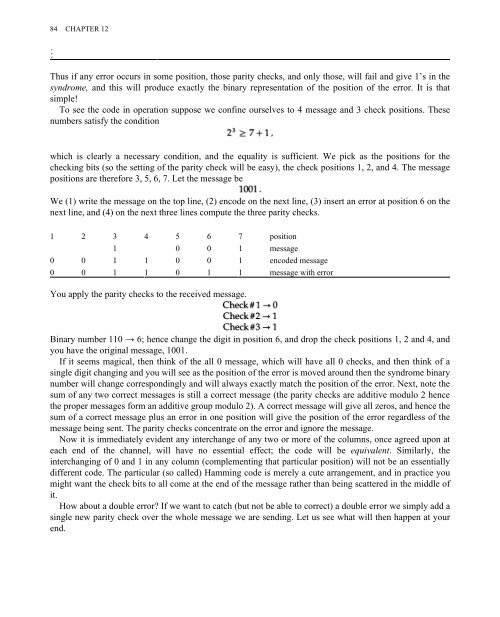hamming
hamming
hamming
Create successful ePaper yourself
Turn your PDF publications into a flip-book with our unique Google optimized e-Paper software.
84 CHAPTER 12Thus if any error occurs in some position, those parity checks, and only those, will fail and give 1’s in thesyndrome, and this will produce exactly the binary representation of the position of the error. It is thatsimple!To see the code in operation suppose we confine ourselves to 4 message and 3 check positions. Thesenumbers satisfy the conditionwhich is clearly a necessary condition, and the equality is sufficient. We pick as the positions for thechecking bits (so the setting of the parity check will be easy), the check positions 1, 2, and 4. The messagepositions are therefore 3, 5, 6, 7. Let the message beWe (1) write the message on the top line, (2) encode on the next line, (3) insert an error at position 6 on thenext line, and (4) on the next three lines compute the three parity checks.1 2 3 4 5 6 7 position1 0 0 1 message0 0 1 1 0 0 1 encoded message0 0 1 1 0 1 1 message with errorYou apply the parity checks to the received message.Binary number 110 → 6; hence change the digit in position 6, and drop the check positions 1, 2 and 4, andyou have the original message, 1001.If it seems magical, then think of the all 0 message, which will have all 0 checks, and then think of asingle digit changing and you will see as the position of the error is moved around then the syndrome binarynumber will change correspondingly and will always exactly match the position of the error. Next, note thesum of any two correct messages is still a correct message (the parity checks are additive modulo 2 hencethe proper messages form an additive group modulo 2). A correct message will give all zeros, and hence thesum of a correct message plus an error in one position will give the position of the error regardless of themessage being sent. The parity checks concentrate on the error and ignore the message.Now it is immediately evident any interchange of any two or more of the columns, once agreed upon ateach end of the channel, will have no essential effect; the code will be equivalent. Similarly, theinterchanging of 0 and 1 in any column (complementing that particular position) will not be an essentiallydifferent code. The particular (so called) Hamming code is merely a cute arrangement, and in practice youmight want the check bits to all come at the end of the message rather than being scattered in the middle ofit.How about a double error? If we want to catch (but not be able to correct) a double error we simply add asingle new parity check over the whole message we are sending. Let us see what will then happen at yourend.


